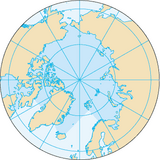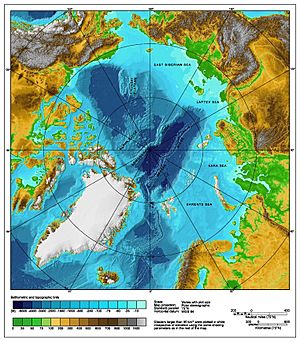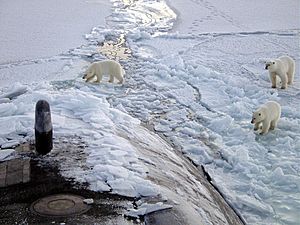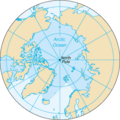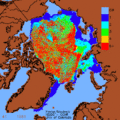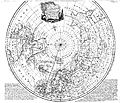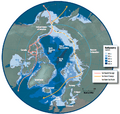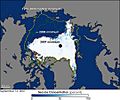Arctic Ocean facts for kids
| Earth's oceans (World Ocean) |
|---|
|
The Arctic Ocean is the smallest and shallowest of the world's five major oceans. It spans an area of approximately 14,060,000 km2 (5,430,000 sq mi) and is known as the coldest of all the oceans.
The Arctic Ocean is the ocean around the North Pole. The most northern parts of Eurasia and North America are around the Arctic Ocean. Thick pack ice and snow cover almost all of this ocean in winter, and most of it in summer. An icebreaker or a nuclear-powered submarine can use the Northwest Passage through the Arctic Ocean to go between the Pacific and Atlantic oceans.
The central surface covered by ice about 3 metres (9.8 feet) thick. The biology there is quite special. Endangered species there include walruses, whales and polar bears. Year by year the Arctic ocean is becoming less icy, as a result of global warming.
The average depth of the Arctic Ocean is 1,038 metres (3,406 feet). The deepest point is in the Eurasian Basin, at 5,450 m (17,881 ft).
Geography
The Arctic Ocean covers an area of about 14,056,000 km2. The coastline is 45,390 km (28,200 mi) long It is surrounded by Eurasia, North America, Greenland, and by several islands.
It is generally taken to include Baffin Bay, Barents Sea, Beaufort Sea, Chukchi Sea, East Siberian Sea, Greenland Sea, Hudson Bay, Hudson Strait, Kara Sea, Laptev Sea, White Sea and other bodies of water. It is connected to the Pacific Ocean by the Bering Strait and to the Atlantic Ocean through the Greenland Sea and Labrador Sea.
Countries bordering the Arctic Ocean are: Russia, Norway, Iceland, Greenland, Canada and the United States.
Climate
The Arctic Ocean is contained in a polar climate. Winters are characterized by the polar night, cold and stable weather conditions, and clear skies.
The temperature of the surface of the Arctic Ocean is fairly constant, near the freezing point of seawater. Arctic Ocean consists of saltwater. The temperature must reach −1.8 °C (28.8 °F) before freezing occurs.
There is considerable seasonal variation in how much pack ice of the Arctic ice pack covers the Arctic Ocean. Much of the Arctic ice pack is covered in snow for about 10 months of the year. The maximum snow cover is in March or April — about 20 to 50 cm (7.9 to 19.7 in).
The climate of the Arctic region has varied significantly in the past. As recently as 55 million years ago, the region reached an average annual temperature of 10–20 °C (50–68 °F). The surface waters of the northernmos. Arctic ocean warmed enough to support tropical lifeforms
Animal and plant life
Endangered marine species in the Arctic Ocean include walruses and whales. The area has a fragile ecosystem which is slow to change and slow to recover from disruptions or damage. Lion's mane jellyfish are abundant in the waters of the Arctic, and the banded gunnel is the only species of gunnel that lives in the ocean.
The Arctic Ocean has relatively little plant life except for phytoplankton. Phytoplankton are a crucial part of the ocean and there are massive amounts of them in the Arctic, where they feed on nutrients from rivers and the currents of the Atlantic and Pacific oceans. During summer, the sun is out day and night, thus enabling the phytoplankton to photosynthesize for long periods of time and reproduce quickly. However, the reverse is true in winter when they struggle to get enough light to survive.
Natural resources
Petroleum and natural gas fields, placer deposits, polymetallic nodules, sand and gravel aggregates, fish, seals and whales can all be found in abundance in the region.
The political dead zone near the center of the sea is also the focus of a mounting dispute between the United States, Russia, Canada, Norway, and Denmark. It is significant for the global energy market because it may hold 25% or more of the world's undiscovered oil and gas resources.
Images for kids
-
The Arctic Ocean, with borders as delineated by the International Hydrographic Organization (IHO), including Hudson Bay (some of which is south of 57°N latitude, off the map).
-
Emanuel Bowen's 1780s map of the Arctic features a "Northern Ocean".
-
The Arctic region showing the Northeast Passage, the Northern Sea Route within it, and the Northwest Passage.
-
A copepod
-
The Kennedy Channel.
See also
 In Spanish: Océano Ártico para niños
In Spanish: Océano Ártico para niños


